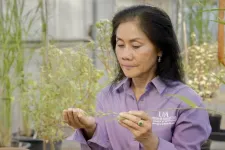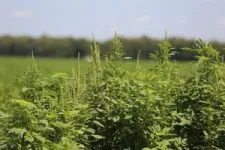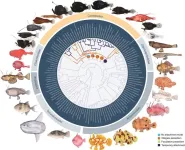(Press-News.org) By John Lovett
University of Arkansas System Division of Agriculture
FAYETTEVILLE, Ark. — It’s not just for burritos and popcorn. Microwave technology is also being tested as a new tool to destroy weed seeds and decrease herbicide use.
Scientists and engineers with the Arkansas Agricultural Experiment Station are investigating the use of 915 MHz microwaves to neutralize a variety of weed seeds underground. The study is supported by a nearly $300,000 Agriculture and Food Research Initiative grant from the U.S. Department of Agriculture’s National Institute of Food and Agriculture, with additional support from The Cotton Board and Cotton Incorporated.
“Even if we can reduce the seed bank by only 50 percent, that would be a lot because the reduction in weed density would greatly increase the efficacy of herbicides and eventually reduce herbicide use,” said Nilda Burgos, professor of weed physiology and molecular biology and principal investigator of the study. “It will be another tool for integrated weed management that is sustainable and non-chemical.”
While studies have shown that burning is very effective at destroying weed seeds, the resulting smoke causes problems with air quality and road visibility. Weed seed crushers are also effective but do not do anything on seeds already dropped, or buried, in the soil. However, the microwave frequency that will be used in the study, which is much lower than that in a home microwave oven, can penetrate below the soil surface to reach weed seeds.
Below the surface
Preliminary studies on 915 MHz frequency microwaves to control weedy rice were conducted by Kaushik Luthra, food science post-doctoral fellow, and Griffiths Atungulu, associate professor and agricultural engineer for grain processing and post-harvest system engineer. Atungulu, co-principal investigator of the new study, is also director of the Arkansas Rice Processing Program and began looking at microwave technology a couple of years ago upon request from Arkansas farmer Chris Isbell of Isbell Farms, who sought non-chemical solutions to problematic weeds.
Similar to a high-frequency home microwave popping popcorn, the low-frequency 915 MHz microwaves also interact with the water molecules inside and on the surface of the weed seeds but penetrate deeper in the soil than high-frequency microwaves can.
“The water molecules constantly try to align with the change in polarity of the microwaves, creating resistance and heat,” Luthra said. “The temperature rises, and the embryo of the seed is destroyed.”
The preliminary studies using low-frequency microwaves inactivated seeds from weedy rice at a 3.5-inch depth and made them mostly inactive at a 6-inch depth. Beneficial microbes recovered quickly after the treatment, a critical component that prompted further studies with the research arm of the University of Arkansas System Division of Agriculture. Beneficial microbes, including fungi, help plants absorb nutrients and help degrade herbicides in the soil.
Although the new study focuses on weeds common in cotton fields, the 10 weeds in the study are also common in other major commodity crops. Amaranthus palmeri, commonly known as Palmer pigweed or Palmer amaranth, will be one of the weed seeds pitted against microwaves. According to the U.S. Department of Agriculture, this prolific pigweed can lead to yield losses up to 91 percent in corn and 79 percent in soybeans by outcompeting the crop. The microwave technology does not discriminate between herbicide-resistant and susceptible weeds; therefore, it is a valuable tool for combatting herbicide-resistant weeds and for reducing weed problems in organic crop production.
Three-pronged approach
In addition to microwave technology, the two-year study will evaluate the effect of a plant-growth regulator to assist herbicide activity on reducing weed fertility and seed germination. Researchers will also look at soil adjuvants, which are additives that can theoretically extend the longevity of pre-emergent herbicides. The study will evaluate the effect of soil adjuvants on herbicide residual activity on fall-planted crops.
Burgos will examine the various treatments for these broadleaf weeds: Palmer pigweed, prickly sida, common lambsquarter, ivyleaf morningglory, common ragweed and spurred anoda. She will also evaluate the treatments on grass weeds including barnyardgrass, goosegrass, Texas panicum and Italian ryegrass.
Microwaves in agriculture
The Rice Processing Program developed microwave technology for high-throughput rice drying and conducted a study to evaluate the 915 MHz microwave frequency’s effect on weedy rice. Burgos said the current study will research the microwave’s breadth of application.
Atungulu chose the frequency of 915 MHz because of its ability to penetrate deeper into the soil and apply heat more evenly, or volumetrically, compared to the 2,450 MHz microwave frequency used in home microwave ovens. When researching microwaves to dry rice in a way that did not compromise grain structural integrity, Atungulu adopted the 915 MHz frequency used by industrial microwaves to thaw frozen meat.
With the ability to adjust the frequency, Atungulu and Burgos plan to study how different frequencies affect weed seeds in various soils and soil depths.
Good soils for growing rice have a hard clay pan to facilitate holding water and flooding. However, cotton “does not like wet feet,” Burgos said, so ideal cotton soils have less clay and are well-drained. The research aims to understand how microwave energy performs within the contrasting soil properties, Burgos added.
Isbell, Atungulu and his team envision using the PTO shaft on a tractor as the energy source for a weed seed-killing microwave implement. The previous studies required 30 kilowatts of power from the 915 MHz microwave system to achieve maximum seed inactivation. A 50-horsepower engine can generate 25 kilowatts of power. Row-crop farmers typically have tractors with larger engines, from 85 to 410 horsepower. Atungulu is seeking funds to build a prototype.
The USDA-NIFA grant number for this project is 2024-67014-41945.
To learn more about Division of Agriculture research, visit the Arkansas Agricultural Experiment Station website: https://aaes.uada.edu. Follow on Twitter at @ArkAgResearch. To learn more about the Division of Agriculture, visit https://uada.edu/. Follow us on Twitter at @AgInArk. To learn about extension programs in Arkansas, contact your local Cooperative Extension Service agent or visit www.uaex.uada.edu.
About the Division of Agriculture
The University of Arkansas System Division of Agriculture’s mission is to strengthen agriculture, communities, and families by connecting trusted research to the adoption of best practices. Through the Agricultural Experiment Station and the Cooperative Extension Service, the Division of Agriculture conducts research and extension work within the nation’s historic land grant education system.
The Division of Agriculture is one of 20 entities within the University of Arkansas System. It has offices in all 75 counties in Arkansas and faculty on five system campuses.
The University of Arkansas System Division of Agriculture offers all its Extension and Research programs and services without regard to race, color, sex, gender identity, sexual orientation, national origin, religion, age, disability, marital or veteran status, genetic information, or any other legally protected status, and is an Affirmative Action/Equal Opportunity Employer.
END
USDA-NIFA grant supports microwave tech to zap weed seeds
Beneficial microbes able to recover in preliminary study on weedy rice
2024-05-23
ELSE PRESS RELEASES FROM THIS DATE:
Research spotlight: AI enabled body composition analysis predicts outcomes for patients with lung cancer treated with immunotherapy
2024-05-23
Tafadzwa Chaunzwa, MD, a researcher in the Artificial Intelligence in Medicine (AIM) Program at Mass General Brigham and a senior resident physician at the Harvard Radiation Oncology Program, is the lead author of a paper published in JAMA Oncology. Chaunzwa and senior author Hugo Aerts, PhD, director of the AIM Program, and associate professor at Harvard University, shared highlights from their paper.
How would you summarize your study for a lay audience?
As treatments like immunotherapy improve cancer survival rates, there is a growing need for clinical decision-support tools that predict treatment response ...
Silky shark makes record breaking migration
2024-05-23
In a recent study, researchers from the Charles Darwin Foundation (CDF), in collaboration with the Guy Harvey Research Institute (GHRI) and Save Our Seas Foundation Shark Research Center (SOSF-SRC) at Nova Southeastern University in Florida, and the Galapagos National Park Directorate (GNPD) have documented the most extensive migration ever recorded for a silky shark (Carcharhinus falciformis), revealing critical insights into the behavior of this severely overfished species and emphasizing the urgent need for cooperative international management measures to prevent further population declines.
The ...
Sexual parasitism helped anglerfish invade the deep sea during a time of global warming
2024-05-23
Members of the vertebrate group including anglerfishes are unique in possessing a characteristic known as sexual parasitism, in which males temporarily attach or permanently fuse with females to mate. Now, researchers reporting in the journal Current Biology on May 23 show that sexual parasitism arose during a time of major global warming and rapid transition for anglerfishes from the ocean floor to the deep, open sea.
The findings have implications for understanding evolution and the effects that global warming may have in the deep sea, according to the researchers.
“Our results show how the ...
Archaeology: Differences in Neanderthal and Palaeolithic human childhood stress
2024-05-23
Neanderthal children (who lived between 400,000 and 40,000 years ago) and modern human children living during the Upper Palaeolithic era (between 50,000 and 12,000 years ago) may have faced similar levels of childhood stress but at different developmental stages, according to a study published in Scientific Reports. The authors suggest that these findings could reflect differences in childcare and other behavioural strategies between the two species.
Laura Limmer, Sireen El Zaatari and colleagues analysed the dental enamel of 423 Neanderthal teeth (from 74 Homo neanderthalensis individuals) and 444 Upper Palaeolithic humans (from 102 Homo sapiens ...
Rising temperatures will significantly reduce streamflow in the upper Colorado river basin as groundwater levels fall, new research shows
2024-05-23
The Colorado River makes life possible in many Western cities and supports agriculture that sustains people throughout the country. Most of the river’s water begins as snowmelt from the mountainous watersheds of Colorado, Utah, and Wyoming, and a warming climate will drastically reduce these streamflows, new research finds.
Researchers from Desert Research Institute (DRI), USGS, and Lawrence Berkeley National Laboratory teamed up for the new study, published May 23 in Nature Water. By applying warming to historical conditions for the East River in Colorado and using computer simulations to observe the impact on streamflow and groundwater ...
Prenatal exposure to chemical mixtures and metabolic syndrome risk in children
2024-05-23
About The Study: The findings of this cohort study suggest that prenatal exposure to endocrine-disrupting chemical mixtures may be associated with adverse metabolic health in children. Given the pervasive nature of endocrine-disrupting chemicals and the increase in metabolic syndrome, these findings hold substantial public health implications.
Corresponding Author: To contact the corresponding author, Martine Vrijheid, Ph.D., email martine.vrijheid@isglobal.org.
To access the embargoed study: Visit our For The Media ...
Effectiveness of a school- and primary care–based HPV vaccination intervention
2024-05-23
About The Study: In this cluster randomized trial, within the context of the late COVID-19 pandemic period and limited school and general practitioner participation, at-school human papillomavirus (HPV) vaccination significantly increased vaccination coverage. The trial did not show a significant effect for training general practitioners and education and motivation, although it may be observed after more time has elapsed after the intervention.
Corresponding Author: To contact the corresponding author, Morgane Michel, Ph.D., email morgane.michel@aphp.fr.
To access the embargoed study: Visit our For The Media website at this link https://media.jamanetwork.com/
(doi:10.1001/jamanetworkopen.2024.11938)
Editor’s ...
Exposure to mixtures of endocrine-disrupting chemicals during pregnancy is associated with higher odds of metabolic syndrome in children
2024-05-23
The term ‘metabolic syndrome’ (MetS) encompasses a group of factors, such as abdominal obesity, hypertension and insulin resistance, that together increase the risk of cardiovascular disease and type 2 diabetes. A new study suggests that prenatal exposure to a combination of endocrine disrupting chemicals (EDCs) is associated with a poorer metabolic health in childhood, which in turn may contribute to an increased risk of metabolic syndrome in adulthood. The research, led by the Barcelona Institute for Global Health (ISGlobal), a centre supported by the "la Caixa" Foundation, has been published in JAMA Network Open.
EDCs ...
Sea of love: Behind the unusual sexual parasitism of deep-water anglerfishes
2024-05-23
New Haven, Conn. – As the planet’s most expansive ecosystem, the deep sea can be a tough place to find a mate. Though, scientists say, some deep-sea anglerfishes evolved a unique method of reproduction that ensures that once they land a partner in the vast open waters, they remain latched for life.
These anglerfishes, called ceratioids, reproduce through sexual parasitism, in which the tiny males attach to their much larger female counterparts to mate. In some species, the males bite the females ...
USTC proposes therapeutic approach for inflammatory bowel disease
2024-05-23
In a study published in Cell Host & Microbe, a research team led by Prof. PAN Wen from the University of Science and Technology of China (USTC) of the Chinese Academy of Sciences, in collaboration with research teams led by Prof. ZHU Shu and Prof. SONG Xinyang, demonstrated the causal link between microbial factors and dysfunction of intestinal stem cells (ISCs) in colitis. On the basis of this mechanism, they proposed a possible approach to restore ISC function in colitis.
Inflammatory bowel disease (IBD) is a chronic disease characterized by the microbial ...
LAST 30 PRESS RELEASES:
Injectable breast ‘implant’ offers alternative to traditional surgeries
Neuroscientists devise formulas to measure multilingualism
New prostate cancer trial seeks to reduce toxicity without sacrificing efficacy
Geometry shapes life
A CRISPR screen reveals many previously unrecognized genes required for brain development and a new neurodevelopmental disorder
Hot flush treatment has anti-breast cancer activity, study finds
Securing AI systems against growing cybersecurity threats
Longest observation of an active solar region
Why nail-biting, procrastination and other self-sabotaging behaviors are rooted in survival instincts
Regional variations in mechanical properties of porcine leptomeninges
Artificial empathy in therapy and healthcare: advancements in interpersonal interaction technologies
Why some brains switch gears more efficiently than others
UVA’s Jundong Li wins ICDM’S 2025 Tao Li Award for data mining, machine learning
UVA’s low-power, high-performance computer power player Mircea Stan earns National Academy of Inventors fellowship
Not playing by the rules: USU researcher explores filamentous algae dynamics in rivers
Do our body clocks influence our risk of dementia?
Anthropologists offer new evidence of bipedalism in long-debated fossil discovery
Safer receipt paper from wood
Dosage-sensitive genes suggest no whole-genome duplications in ancestral angiosperm
First ancient human herpesvirus genomes document their deep history with humans
Why Some Bacteria Survive Antibiotics and How to Stop Them - New study reveals that bacteria can survive antibiotic treatment through two fundamentally different “shutdown modes”
UCLA study links scar healing to dangerous placenta condition
CHANGE-seq-BE finds off-target changes in the genome from base editors
The Journal of Nuclear Medicine Ahead-of-Print Tip Sheet: January 2, 2026
Delayed or absent first dose of measles, mumps, and rubella vaccination
Trends in US preterm birth rates by household income and race and ethnicity
Study identifies potential biomarker linked to progression and brain inflammation in multiple sclerosis
Many mothers in Norway do not show up for postnatal check-ups
Researchers want to find out why quick clay is so unstable
Superradiant spins show teamwork at the quantum scale
[Press-News.org] USDA-NIFA grant supports microwave tech to zap weed seedsBeneficial microbes able to recover in preliminary study on weedy rice






